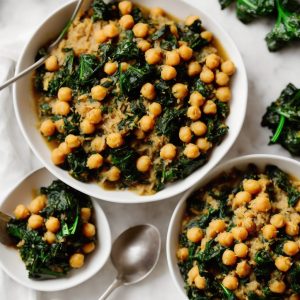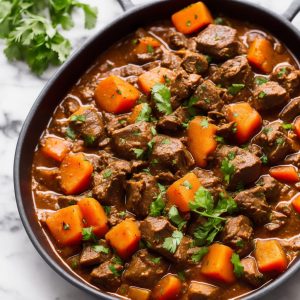This hearty root vegetable stew is a delightful blend of earthy flavors and aromatic spices. It's a warming, comforting dish that's perfect for chilly nights. The recipe incorporates a variety of root vegetables such as potatoes and carrots, mixed with exotic Turkish apricots for a surprising twist. The flavors come together beautifully, creating a stew that's not only delicious but also packed with nutrients.
Some of the ingredients like Turkish apricots may not be readily available in your pantry. These are dried fruit from the apricot trees found in Turkey, known for their sweet, tart flavor. They're available in most supermarkets, often in the dried fruit aisle. If you can't find them, you can substitute for other dried fruits like prunes or dates. Additionally, ground coriander and cumin, integral to the flavor profile of this stew, can be found in the spice section.
Key Ingredients for Root Vegetable Stew
Olive oil: Used for sautéing the onions and garlic. It adds a rich, earthy flavor to the stew.
Canola oil: Mixed with olive oil to balance the flavors.
Yellow onions: They add a sweet, caramel-like flavor when browned.
Yukon gold potatoes: These potatoes have a buttery texture after cooking, perfect for stews.
Chickpeas: They add a nice, hearty texture to the stew.
Carrots: Carrots add a natural sweetness and vibrant color to the stew.
Garlic: Adds a punch of flavor.
Vegetable broth: Forms the base of the stew.
Ground ginger, cumin, coriander, salt, black pepper, and cinnamon: These spices give the stew its warm, comforting flavor.
Turkish apricots: They add a touch of unexpected sweetness and tartness to the stew.
Cherries: Used for garnish and added flavor.
Pita bread: Perfect for dipping into the stew.
One reader, Charmion Adamson says:





This root vegetable stew recipe is a game-changer! The blend of spices and the hearty mix of potatoes, carrots, and chickpeas create a comforting and flavorful dish. The addition of apricots and cherries adds a delightful sweetness. It's a must-try for anyone looking for a satisfying and wholesome meal.
Techniques Required for Making Root Vegetable Stew
How to brown onions: Heat olive and canola oil in a large heavy-bottomed pot, then add the onions and cook on high heat until they turn golden brown, stirring occasionally.
How to release the flavor of spices: Add the ground ginger, ground cumin, ground coriander, salt, ground black pepper, and ground cinnamon to the browned onions and cook for about 15 seconds to release the flavors of the spices.
How to serve the stew: Spoon the stew into a bowl and garnish with chopped parsley if desired. It can also be topped with additional chopped apricots and dried cherries for added flavor.
How to puree for children: Add the stew and some water to a small food processor and puree until smooth for children who are eating purees.
How to serve for children: If children are able to eat on their own, make the puree and add some pita triangles to serve as a dip. Adding chopped apricots and cherries can make it more appealing to children.
How to elevate the presentation: Consider serving the stew over some orzo or brown rice, and think about the presentation on the plates or matching napkins to enhance the dining experience.
How to make the stew more fancy: You can also make the stew more fancy by serving it over orzo or brown rice and considering the presentation on the plates or matching napkins.
How to make the stew appealing to kids: Adding chopped apricots and cherries can make the stew more appealing to kids, as the bright fruit flavor is something they may really appreciate.
How To Make Root Vegetable Stew
A warm comforting bowl of stew with carrots, chickpea, and other root vegetables. You can easily make this dish in under an hour.
Serves:
Ingredients
- 1tbspolive oil
- 1tbspcanola oil
- 2small yellow onion,diced
- 2lbsyukon gold potatoes,scrubbed clean and diced
- 2canschickpeas,drained
- 1lbcarrots,peeled and diced
- 3large garlic cloves,minced
- 4cupsvegetable broth
- 1cupwater
- 2tspground ginger,or equal amount of fresh ginger, minced very finely
- 1tbspground cumin
- 2tspground coriander
- 2tspsalt
- ¼tspground black pepper
- ½tspground cinnamon
- ¼: 5px”>cherries,dried, optional
- turkish apricots,additional chopped dried for garnish, optional
- pita bread,to serve or scoop or dip with
Instructions
-
Put olive and canola oil in large heavy bottomed pot. Brown onions on high heat.
-
Add spices and garlic to onions and cook for another 15 seconds to release the flavor of the spices.
-
Add broth and water to pot. Add potatoes and carrots and chopped apricots.
-
Cook uncovered on high for 20 to 30 minutes or until the potatoes start to break down in stew and the liquids have been absorbed.
-
To serve, spoon into bowl, garnish with chopped parsley if desired.
-
Also delicious if topped with additional chopped apricots and dried cherries.
-
For children eating purees, add water to small food processor and puree until smooth.
-
If able to eat on their own, you can make the puree and add some pita triangles to serve as a dip.
-
My daughter loves anything she can dip. You could also add the chopped apricots and cherries and call them sprinkles.
-
The bright fruit flavor is something your kid may really appreciate.
-
It is a bit difficult to make a stew into something more fancy, but think of your plates, or matching napkins.
-
You can also serve the stew over some orzo or brown rice.
Nutrition
- Calories: 308.18kcal
- Fat: 6.98g
- Saturated Fat: 0.69g
- Trans Fat: 0.01g
- Monounsaturated Fat: 3.08g
- Polyunsaturated Fat: 1.87g
- Carbohydrates: 53.24g
- Fiber: 11.80g
- Sugar: 9.14g
- Protein: 10.97g
- Sodium: 910.65mg
- Calcium: 106.52mg
- Potassium: 870.83mg
- Iron: 3.00mg
- Vitamin A: 483.62µg
- Vitamin C: 28.63mg
Crucial Technique Tip for Perfecting Your Root Vegetable Stew
When preparing your root vegetable stew, it's important to remember that the size of your vegetable chunks matters. For a more rustic, hearty stew, leave your potatoes and carrots in larger pieces. If you prefer a smoother, more blended stew, cut your vegetables into smaller pieces. They will break down more during cooking, creating a thicker, creamier stew. Also, don't forget to sauté your onions and garlic until they're golden brown. This caramelization process will add a depth of flavor to your stew that can't be achieved otherwise. Lastly, don't rush the cooking process. Letting the stew simmer will allow the flavors to meld together and the vegetables to become tender.
Time-Saving Tips for Preparing Root Vegetable Stew
Prep ahead: Chop and prepare all the vegetables and ingredients in advance to save time during the cooking process.
One-pot wonder: Use a large, heavy-bottomed pot to cook the stew, minimizing the number of dishes to clean up afterward.
Quick release: Utilize a pressure cooker to significantly reduce the cooking time for the root vegetable stew.
Frozen convenience: Consider using pre-cut frozen vegetables to skip the time-consuming task of peeling and chopping fresh produce.
Multitask: While the stew is simmering, use the time to prepare a simple side dish or salad to accompany the meal.
Efficient tools: Invest in quality kitchen tools such as a sharp chef's knife and a vegetable peeler to streamline the prep work.
Leftover magic: Repurpose any leftover root vegetable stew into a delicious pot pie or shepherd's pie for a quick and satisfying meal.
Batch cooking: Double the recipe and freeze individual portions for future quick and convenient meals.
Smart substitutions: Substitute canned or pre-cooked chickpeas to save time and avoid the need for soaking and boiling dried chickpeas.
Flavor shortcut: Use pre-made spice blends or seasoning mixes to cut down on the time spent measuring and combining individual spices.
Substitute Ingredients For Root Vegetable Stew Recipe
olive oil - Substitute with avocado oil: Avocado oil has a similar smoke point and mild flavor, making it a suitable replacement for olive oil in this recipe.
canola oil - Substitute with grapeseed oil: Grapeseed oil is a neutral-flavored oil with a high smoke point, making it a good alternative to canola oil for sautéing and cooking.
yellow onion - Substitute with white onion: White onions have a slightly milder flavor compared to yellow onions and can be used as a substitute in this recipe.
yukon gold potatoes - Substitute with red potatoes: Red potatoes have a similar texture and flavor to Yukon gold potatoes, making them a suitable replacement in the stew.
chickpeas - Substitute with cannellini beans: Cannellini beans have a creamy texture and mild flavor, making them a good substitute for chickpeas in the stew.
carrots - Substitute with parsnips: Parsnips have a slightly sweeter and nuttier flavor than carrots, making them a delicious alternative in the root vegetable stew.
garlic cloves - Substitute with shallots: Shallots have a mild garlic flavor and can be used as a substitute for garlic cloves in this recipe.
vegetable broth - Substitute with mushroom broth: Mushroom broth adds a rich umami flavor and depth to the stew, making it a great alternative to vegetable broth.
ground ginger - Substitute with freshly grated ginger: Freshly grated ginger provides a more intense and fresher flavor compared to ground ginger, enhancing the taste of the stew.
ground cumin - Substitute with ground coriander: Ground coriander has a citrusy and slightly sweet flavor, which can replace the earthy warmth of cumin in the stew.
ground coriander - Substitute with ground cardamom: Ground cardamom adds a warm, citrusy flavor that can substitute for the aromatic notes of coriander in the stew.
salt - Substitute with tamari: Tamari is a gluten-free soy sauce that adds a savory umami flavor and can be used as a substitute for salt in the stew.
ground black pepper - Substitute with white pepper: White pepper has a milder and less pungent flavor compared to black pepper, making it a suitable replacement in the stew.
ground cinnamon - Substitute with ground nutmeg: Ground nutmeg has a warm and slightly sweet flavor that can replace the aromatic notes of cinnamon in the stew.
turkish apricots - Substitute with dried figs: Dried figs add a natural sweetness and a chewy texture, similar to Turkish apricots, enhancing the flavor and texture of the stew.
cherries - Substitute with dried cranberries: Dried cranberries provide a sweet and tart flavor, similar to cherries, and can be used as a substitute in the root vegetable stew.
pita bread - Substitute with naan bread: Naan bread is a soft and fluffy flatbread that can be served alongside the stew, complementing the flavors and textures of the dish.
Presenting Your Delicious Root Vegetable Stew
Elevate the stew with a refined plating: Present the stew in a shallow bowl, allowing the vibrant colors of the root vegetables to shine through. Arrange the chickpeas and carrots strategically, creating a visually appealing composition.
Garnish with a touch of elegance: Sprinkle a pinch of finely chopped parsley over the stew, adding a pop of color and a hint of freshness to the dish.
Artful drizzle of olive oil: Before serving, delicately drizzle a swirl of high-quality olive oil on top of the stew, enhancing the flavors and adding a touch of sophistication to the presentation.
Accompany with homemade pita bread: Serve warm, freshly baked pita bread on the side, elegantly arranged in a basket or on a wooden board, inviting diners to savor the stew with a delightful accompaniment.
Incorporate a touch of sweetness: Place a single dried cherry on top of the stew, adding a burst of sweetness and a visually striking element to the presentation.
Consider the vessel: Serve the stew in a beautiful, artisan-crafted ceramic bowl, enhancing the dining experience and adding a touch of luxury to the presentation.
Embrace minimalism: Keep the presentation clean and minimal, allowing the natural beauty of the stew and its ingredients to take center stage.
Balance and symmetry: Arrange the components of the dish with precision, creating a sense of balance and symmetry on the plate for a visually stunning presentation.
Elevate with edible flowers: Consider garnishing the stew with a delicate edible flower, such as a nasturtium or pansy, to add a touch of elegance and a subtle floral note to the presentation.
Serve in a unique vessel: Present the stew in a hollowed-out acorn squash or a small, rustic cast-iron cocotte, adding an element of surprise and creativity to the presentation.
Essential Tools for Making a Hearty Root Vegetable Stew
- Large heavy bottomed pot: This is essential for cooking the stew as it provides a large surface area for browning the onions and allows for even heat distribution while simmering the stew.
- Food processor: This tool is useful for pureeing the stew to a smooth consistency, especially if serving it to children or for creating a dip with pita bread.
- Knife: A sharp knife is necessary for chopping the vegetables and fruits, such as onions, potatoes, carrots, and apricots, with precision.
- Cutting board: This provides a stable surface for chopping and preparing the vegetables and fruits for the stew.
- Wooden spoon: A wooden spoon is ideal for stirring the stew as it does not conduct heat and is gentle on the pot's surface.
- Measuring cups and spoons: These are essential for accurately measuring the ingredients, such as vegetable broth, spices, and water, to ensure the stew turns out flavorful and balanced.
- Can opener: This is necessary for opening the cans of chickpeas, which are a key ingredient in the stew.
- Potato peeler: This tool is needed for peeling the potatoes before chopping them for the stew.
- Grater: A grater can be used to grate fresh ginger, which adds a vibrant and aromatic flavor to the stew.
- Serving bowls and utensils: These are necessary for serving the stew and for garnishing with parsley, chopped apricots, and dried cherries.
Storing and Freezing Your Homemade Root Vegetable Stew
Allow the root vegetable stew to cool completely before storing or freezing. This will prevent condensation from forming and potentially spoiling the stew.
For short-term storage, transfer the cooled stew to an airtight container and refrigerate for up to 4-5 days. The flavors will continue to meld and develop over time, making the stew even more delicious.
If you plan to freeze the stew, consider portioning it into individual serving sizes for convenience. This allows you to thaw only what you need for a quick and easy meal later on.
Use freezer-safe containers or resealable bags to store the stew in the freezer. Make sure to leave some headspace at the top of the container to allow for expansion during freezing.
Label the containers or bags with the date and contents to keep track of your frozen meals. The root vegetable stew can be stored in the freezer for up to 3 months.
When ready to enjoy the frozen stew, thaw it overnight in the refrigerator. If you need to thaw it more quickly, you can use the defrost setting on your microwave or place the container in a bowl of cold water, changing the water every 30 minutes until the stew is thawed.
Reheat the thawed stew in a pot on the stovetop over medium heat, stirring occasionally, until it is heated through. You may need to add a little broth or water to adjust the consistency if the stew has thickened during storage.
If you have added any toppings or garnishes, such as chopped apricots, cherries, or parsley, it's best to add them fresh when serving the reheated stew for optimal texture and flavor.
How To Reheat Leftover Root Vegetable Stew
Reheat the leftover root vegetable stew in a saucepan over medium-low heat, stirring occasionally, until it reaches the desired temperature. This method allows the flavors to meld together even more, creating a richer and more comforting dish.
If the stew has thickened too much during storage, add a splash of vegetable broth or water to thin it out while reheating. Adjust the seasoning with salt and pepper if needed.
For a quicker reheating option, transfer individual portions of the stew into microwave-safe bowls. Cover the bowls with a damp paper towel to prevent splattering and to help retain moisture. Microwave on high for 1-2 minutes, stirring halfway through, until the stew is heated through.
To add a fresh twist to your leftover stew, serve it over a bed of fluffy couscous, quinoa, or rice. The grains will soak up the flavorful broth and provide a satisfying contrast in texture.
Transform your leftover stew into a comforting pot pie. Transfer the stew into a baking dish, top it with a layer of puff pastry or pie crust, and bake in a preheated oven until the crust is golden brown and the filling is bubbly.
For a crispy twist, reheat the stew in a saucepan until warm, then serve it over a slice of toasted sourdough bread. The bread will absorb the rich broth while providing a satisfying crunch.
Create a fusion dish by using your leftover stew as a filling for tacos or burritos. Reheat the stew, then spoon it into warm tortillas and top with fresh cilantro, diced onions, and a squeeze of lime juice.
Interesting Trivia About Root Vegetable Stew
The root vegetable stew recipe is a hearty and nutritious dish that can be customized to suit different tastes and dietary needs. It's a great way to incorporate a variety of root vegetables and legumes into your diet, providing essential nutrients and fiber. This stew can be a versatile meal option, as it can be served as a standalone dish or paired with grains such as orzo or brown rice. Additionally, it offers a creative way to introduce fruits like apricots and cherries into savory recipes, adding a unique and delightful flavor profile to the dish.
Is Making Root Vegetable Stew Budget-Friendly?
This root vegetable stew recipe is highly cost-effective for a household. The use of affordable and readily available ingredients like potatoes, carrots, and chickpeas makes it budget-friendly. The addition of spices and dried fruits enhances the flavor without breaking the bank. The approximate cost for a household of 4 people is around $15, making it an economical choice. The versatility of this stew also adds value, as it can be served with pita bread or over grains, catering to various preferences. Overall Verdict: 9/10.
Is This Root Vegetable Stew Healthy or Unhealthy?
This root vegetable stew recipe is a nutritious and wholesome dish that offers several health benefits:
- The recipe is rich in fiber, thanks to the inclusion of potatoes, carrots, chickpeas, and apricots. Fiber aids in digestion and promotes a healthy gut.
- The use of olive and canola oil provides healthy unsaturated fats, which are essential for heart health and brain function.
- The combination of spices, such as ginger, cumin, coriander, and cinnamon, not only adds flavor but also offers anti-inflammatory properties and may boost metabolism.
- The recipe is vegetarian and can easily be made vegan by using vegetable broth, making it suitable for various dietary preferences.
To further enhance the nutritional value of this stew, consider the following suggestions:
- Incorporate more leafy greens, such as spinach or kale, to increase the vitamin and mineral content.
- Replace some of the potatoes with other nutrient-dense root vegetables like sweet potatoes or parsnips for added variety and flavor.
- Experiment with different types of legumes, such as lentils or kidney beans, to increase the protein content and create a more filling meal.
- Serve the stew with a side of quinoa or brown rice to add more complex carbohydrates and fiber to the dish.
- Garnish with fresh herbs like cilantro or parsley to boost the vitamin content and add a pop of color and freshness to the stew.
Editor's Opinion on This Delightful Root Vegetable Stew Recipe
The root vegetable stew recipe is a hearty and flavorful dish that combines the earthy sweetness of yukon gold potatoes, carrots, and chickpeas with a fragrant blend of spices. The addition of Turkish apricots and cherries adds a delightful touch of sweetness and complexity to the stew. The instructions are clear and easy to follow, making it accessible for home cooks of all skill levels. The suggestion to serve the stew with pita bread or over orzo and brown rice provides versatility and allows for a customizable dining experience. Overall, this recipe offers a delicious and nutritious option for a comforting meal.
Enhance Your Root Vegetable Stew Recipe with These Unique Side Dishes:
Delicious Alternatives to Root Vegetable Stew
Appetizers and Desserts That Complement Root Vegetable Stew
Why trust this Root Vegetable Stew Recipe:
This stew recipe is a testament to the power of root vegetables. The combination of yukon gold potatoes, carrots, and chickpeas creates a hearty and nutritious base. The infusion of ground ginger, cumin, and coriander adds depth and warmth to the stew. The inclusion of turkish apricots and cherries provides a delightful hint of sweetness. The use of pita bread as a side elevates the dining experience. Trust in the harmonious blend of flavors and textures in this stew for a truly satisfying meal.
Was this page helpful?
Have your own special recipe to share? Submit Your Recipe Today!














